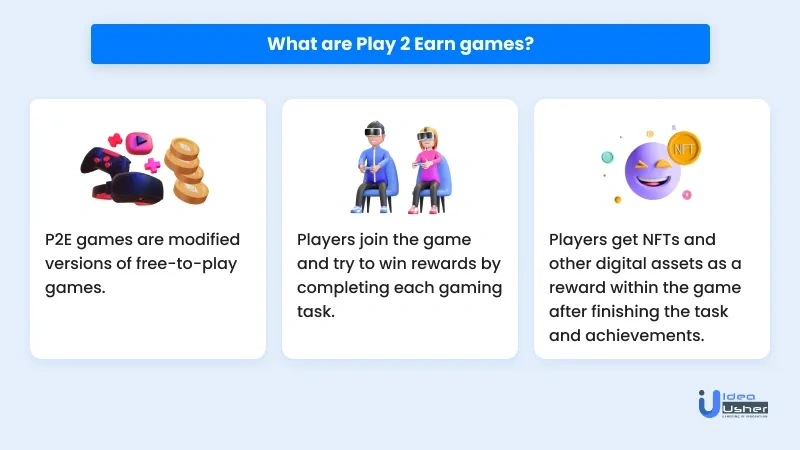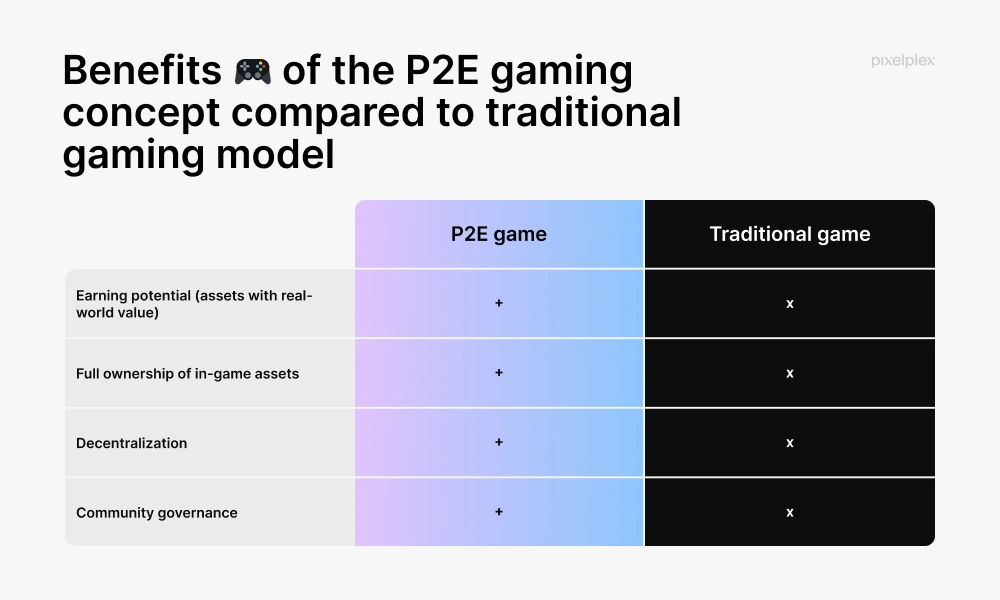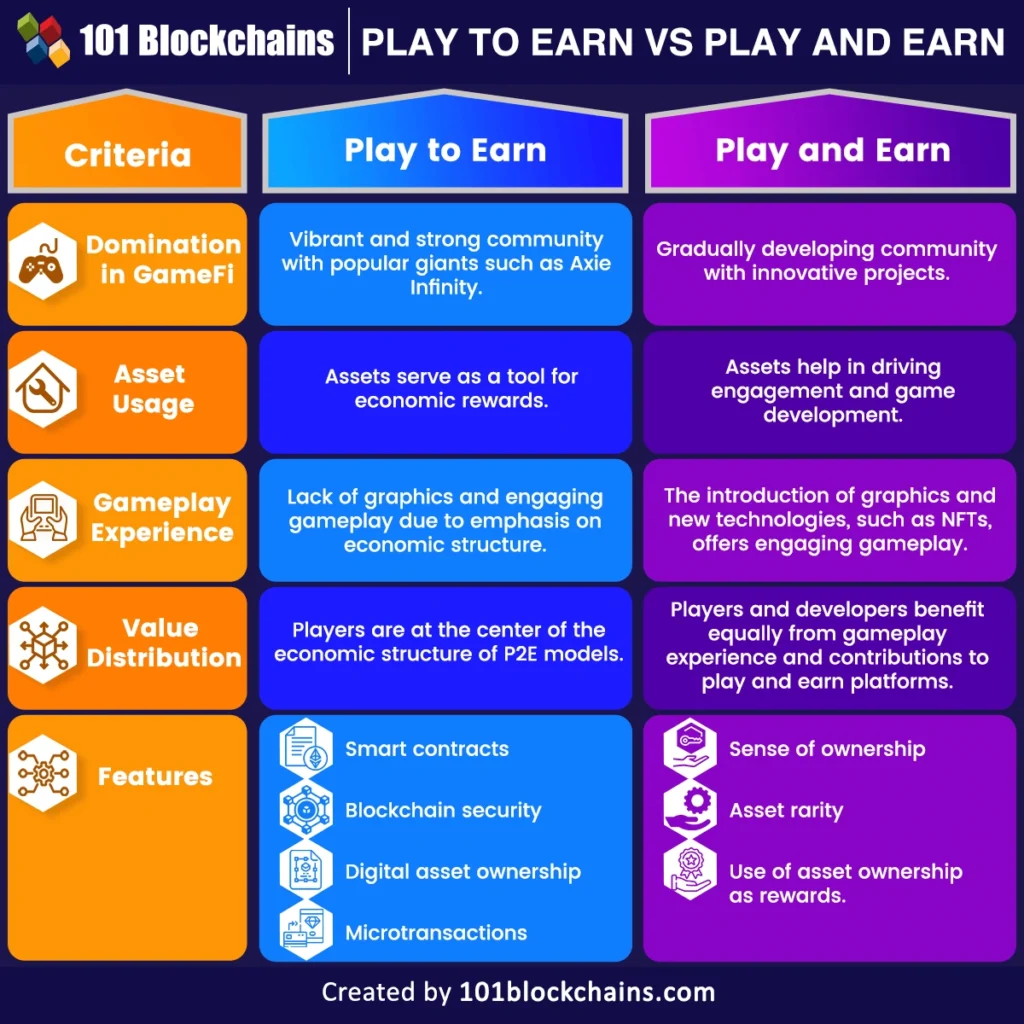Play to Earn Crypto Games: A Beginner’s Guide to Gaming with Real Rewards
Gaming is no longer just about entertainment. Over the past few years, play to earn crypto games—commonly known as P2E—have introduced a new way for players to turn in-game achievements into real-world income. Through the integration of blockchain technology, these games offer more than just fun—they provide actual ownership, financial rewards, and participation in decentralized economies.
This guide explores how P2E works, what sets it apart from traditional gaming, the risks involved, and what newcomers need to know before getting started.
What Is Play to Earn and How Does It Work?

Credit from IdeaUsher
At its core, play-to-earn gaming allows players to earn digital assets—usually in the form of cryptocurrency or NFTs (non-fungible tokens)—as rewards for playing. These assets aren’t confined to a single platform. Players can sell them, trade them, or store them for future use. The technology behind this model is blockchain, which keeps transactions secure, transparent, and decentralized.
When players engage in a P2E game, they typically complete missions, win battles, or level up characters. Instead of being rewarded with points that stay within the game, they receive tokens or items that can be monetized. Some games also allow players to own virtual land, rent out their characters, or earn governance rights through token ownership. This changes the fundamental nature of gaming from a closed system into an open economy.
The Infrastructure Behind P2E Games
The concept might seem futuristic, but it rests on a few key components:
Blockchain serves as the foundation, recording ownership of items, characters, or land on a decentralized ledger. This means assets can’t be duplicated or removed by a central authority.
Cryptocurrencies act as the in-game currency. Depending on the game, players might earn native tokens that can be exchanged for more widely accepted coins like Ethereum or even converted into fiat currencies.
NFTs give players true digital ownership. Whether it’s a rare sword, a custom skin, or a plot of land in a virtual world, each item is unique and tradable.
Smart contracts ensure automated and secure transactions. For instance, if a player wins a tournament, a smart contract can immediately transfer the prize to their wallet.
These elements combine to give players both agency and incentive to participate beyond just the gameplay experience.
P2E in Practice: Real-World Examples
Some of the most popular play-to-earn games have already gained global recognition. Each one brings a unique experience, ecosystem, and community.
| Game Title | Blockchain | Token(s) | Key Features |
|---|---|---|---|
| Axie Infinity | Ronin | AXS, SLP | Pet battles, breeding mechanics, NFT marketplace |
| The Sandbox | Ethereum | SAND | Virtual land creation, user-generated content |
| Illuvium | Immutable X | ILV | High-fidelity auto-battler, collectible NFTs |
| Big Time | Ethereum (L2) | Cosmetic NFTs | Action RPG gameplay with time-travel themes |
| Star Atlas | Solana | ATLAS, POLIS | Space strategy with deep economic layers |
While each title differs in gameplay and graphics, they share one goal: reward players for their contributions and time. In some regions, these games have become an income source, with communities forming around them in places like Southeast Asia and Latin America.
What Sets Play-to-Earn Apart from Traditional Gaming

Credit from Pixelplex.io
The most significant shift lies in asset ownership. In conventional games, players may spend hundreds of hours unlocking rare items, only to have them permanently tied to their account or lost if the game shuts down. In contrast, P2E games allow you to retain and control these items through your crypto wallet.
Earning potential is another key difference. While traditional gaming offers income mostly through content creation or competitive tournaments, P2E gives everyday players a chance to earn as they play. This lowers the barrier to monetization and introduces new pathways for financial inclusion.
Additionally, many P2E games involve community governance. Token holders may vote on updates or game rules, giving them a real stake in the ecosystem—something unheard of in traditional game models.
Why Some Players Are Turning to P2E
The appeal of P2E is strong, especially in countries where earning power through traditional means is limited. A gamer with basic internet access could, in theory, turn a few hours of play into real money by collecting and trading digital assets.
Ownership of in-game items also provides a sense of control and freedom. Players can take their assets across platforms, sell them to other players, or even use them in other games that support the same blockchain. This flexibility has never existed in gaming before.
For developers, the model offers new monetization strategies. Rather than relying solely on game sales or in-game purchases, studios can generate revenue through NFT sales, transaction fees, and community funding models.
The Risks of Play-to-Earn Games
Despite their promise, P2E games come with notable challenges.
One of the most pressing is volatility. Game tokens can swing dramatically in value. A token that was worth a substantial amount yesterday may be nearly worthless today due to market shifts or a drop in active players.
Security concerns are also significant. Blockchain wallets and smart contracts have become targets for hackers, as seen in high-profile cases like the Ronin bridge exploit in Axie Infinity, which led to losses of over $600 million.
There’s also the issue of sustainability. Many P2E ecosystems have collapsed due to poor economic design. If a game rewards too many tokens without controlling supply, inflation can devalue the entire system, driving users away.
Legal clarity remains elusive. In some countries, regulators view P2E as gambling or taxable income. Others haven’t yet addressed the issue. Beginners should be cautious and check local regulations before committing financially.
Getting Started as a New Player in Play to Earn Crypto Games
Starting your journey in play-to-earn doesn’t require much technical knowledge, but it does involve a few basic steps. First, you’ll need a digital wallet—MetaMask is a popular option for Ethereum-based games. After that, you’ll typically need to purchase some cryptocurrency to access the game or buy necessary NFTs.
Some games are free to start, especially newer titles seeking to attract users. Others may require upfront investment—sometimes in the hundreds of dollars—to buy characters, equipment, or land.
It’s important to read reviews, watch gameplay, and understand the tokenomics before diving in. Many communities offer guides, forums, and YouTube tutorials that help demystify the onboarding process.
Is Play-to-Earn the Future of Gaming?

Credit from 101 Blockchains
The P2E model is still evolving. Early adopters saw massive gains, but also witnessed sharp downturns. The next phase appears to be more cautious, focusing on quality gameplay and long-term viability over quick profits.
Many developers are moving toward hybrid models that blend free-to-play with earning elements. These aim to make games more accessible while still rewarding the most engaged players. Skill-based earning and player-created content are also emerging trends, suggesting a more mature and sustainable future.
Games like Ember Sword, Shrapnel, and Guild of Guardians are promising examples of this next generation of blockchain gaming.
Final Thoughts on Play to Earn Crypto Games
The rise of play to earn crypto games reflects a broader shift in how we think about digital value and participation. These games invite players not just to consume content, but to contribute, earn, and take ownership of their digital experiences. For beginners, the world of P2E may seem complex, but with careful exploration, it offers a compelling new dimension of gaming.
Whether you’re curious about earning rewards or simply interested in the technology, play-to-earn is a space worth watching. Just be sure to approach it not just as a gamer—but also as a learner and critical thinker.




